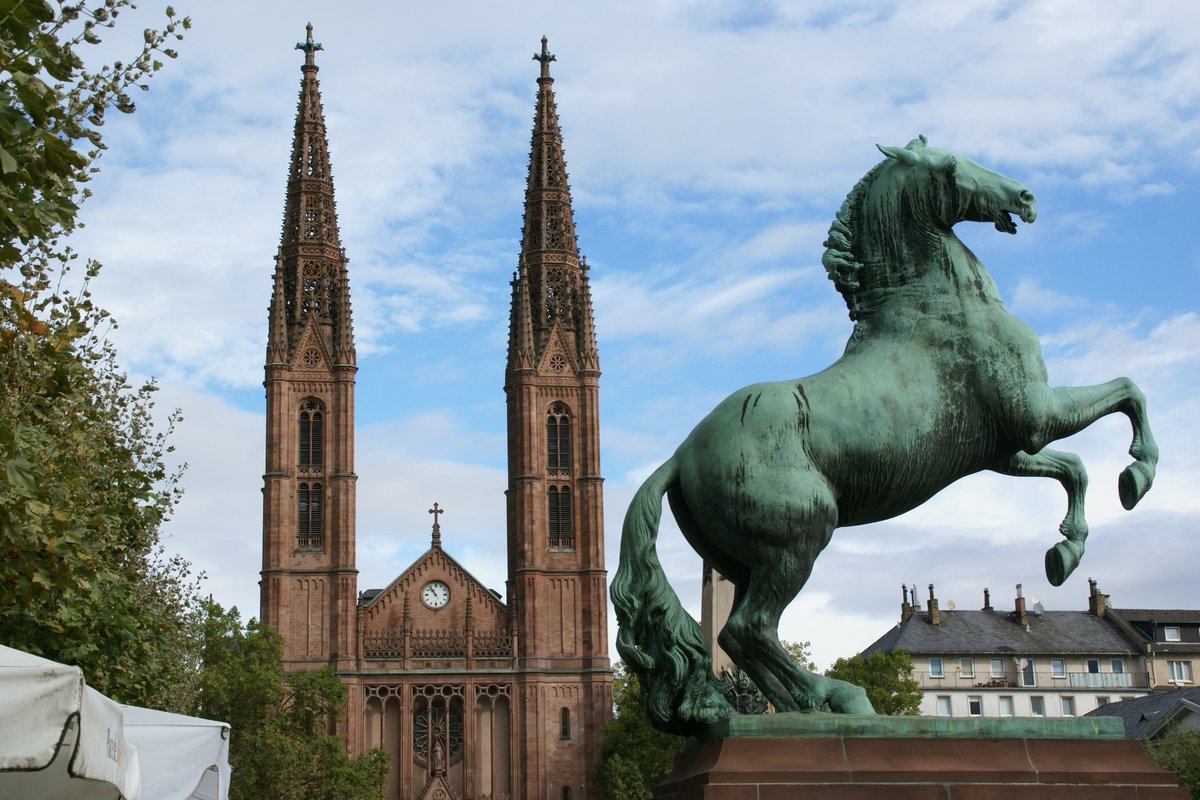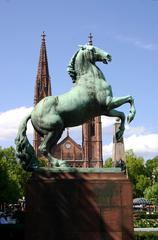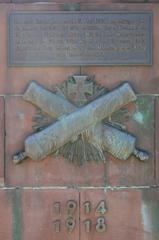
Oraniendenkmal Wiesbaden: Visiting Hours, Tickets, and Historical Significance
Date: 14/06/2025
Introduction
The Oraniendenkmal in Wiesbaden is a landmark steeped in history and cultural significance, drawing visitors interested in Germany’s military past, dynastic ties, and the evolution of civic memory. Wiesbaden is home to two prominent Oraniendenkmal monuments: one at Schlossplatz, dedicated to William I of Orange (“the Silent”), and another at Luisenplatz, commemorating the 1st Nassau Field Artillery Regiment No. 27 Oranien. Both sites provide valuable insights into Wiesbaden’s layered heritage, making them must-see attractions for history enthusiasts and casual travelers alike (wiesbaden.de).
Historical Background
The William of Orange Monument (Schlossplatz)
Commissioned by Kaiser Wilhelm II and inaugurated in 1908, the Oraniendenkmal at Schlossplatz honors William I of Orange, a central figure in the Dutch struggle for independence and a symbol of Protestant values. Known as “Der Schweiger” (The Silent One), William’s leadership during the Eighty Years’ War and his advocacy for religious tolerance earned him a lasting legacy. The monument’s placement in front of the neo-Gothic Marktkirche underscores its religious and cultural importance (wiesbaden.de).
Community involvement played a role in selecting the monument’s precise location. Citizens constructed and moved a life-size model around the city before Kaiser Wilhelm II chose its final site. The statue depicts William in a contemplative pose, and its pedestal inscription commemorates his assassination in 1584 for his Protestant faith (flickr.com).
The Regiment Memorial (Luisenplatz)
At Luisenplatz stands the second Oraniendenkmal, erected in 1934 to honor the 1st Nassau Field Artillery Regiment No. 27 Oranien. The regiment’s history dates back to 1866, with close ties to both Nassau and the Dutch House of Orange-Nassau. The monument was realized through the efforts of veterans and the local community, with the city council eventually approving its prominent placement at Luisenplatz (Wiesbaden Stadtlexikon).
The central artistic feature is a dynamic bronze sculpture of a rearing horse—created by Professor Paul Scheurich—symbolizing the regiment’s spirit and resilience. The base, crafted from Main sandstone, is inscribed with the regiment’s battles and the motto, “Loyal to the fatherland I remain until death.” A plaque added in 1989 commemorates Dr. Hermann Kaiser, a resistance fighter and key advocate for the memorial (Wiesbaden Stadtlexikon).
Monument Composition and Design
Artistic Features
-
Schlossplatz Monument: Features a dignified bronze statue of William of Orange, reinforcing his reputation as a thoughtful and steadfast leader. The inscription on the pedestal references his sacrifice for religious freedom (flickr.com).
-
Luisenplatz Monument: The rearing bronze horse by Paul Scheurich is a striking symbol of military prowess and loyalty. The Main sandstone pedestal is adorned with an artillery emblem and lists the regiment’s engagements.
Materiality and Style
Both monuments reflect the aesthetics of their respective eras: the Schlossplatz statue aligns with early 20th-century imperial commemorative art, while the Luisenplatz memorial’s naturalistic style and dynamic posture convey interwar themes of resilience.
Location and Accessibility
-
Schlossplatz Oraniendenkmal: Located in front of the Marktkirche, easily reachable by public transport and a short walk from Wiesbaden Hauptbahnhof. The site is barrier-free and open 24/7, with no entry fees (wiesbaden.de).
-
Luisenplatz Oraniendenkmal: Situated at a central urban hub surrounded by classicist architecture and public amenities. The area is accessible for visitors with disabilities and is well-served by bus lines 1 and 8 (Wiesbaden Stadtlexikon).
Visiting Information
- Hours: Both monuments are outdoors and accessible 24/7.
- Admission: No tickets or entrance fees are required.
- Guided Tours: Included in many local walking tours; audio guides are available via apps like Audiala (rhein-reisefuehrer.de).
- Amenities: Cafés, shops, and public restrooms are nearby. The surrounding plazas are ideal for rest and reflection.
Nearby Attractions
- Marktkirche: Neo-Gothic Protestant church near Schlossplatz.
- Rathaus: Wiesbaden’s historic town hall.
- Kurhaus: Renowned spa house and event venue.
- Bonifatiuskirche: Neo-Gothic Catholic church adjacent to Luisenplatz.
- Wilhelmstraße: Shopping and culture boulevard within walking distance.
Cultural and Memorial Significance
The Oraniendenkmal monuments are focal points for public remembrance, cultural events, and educational initiatives. They highlight Wiesbaden’s connections to the House of Orange-Nassau and its military tradition while encouraging critical reflection on loyalty, sacrifice, and civic courage, especially with the addition of the Hermann Kaiser plaque (Wiesbaden Stadtlexikon).
Visitor Experience and Practical Tips
- Best Times to Visit: Daylight hours are ideal for viewing the artistic details and inscriptions. Early mornings and late afternoons offer pleasant lighting and fewer crowds.
- Accessibility: Both sites are barrier-free and suitable for wheelchair users.
- Photography: Encouraged, especially with the dramatic backdrops of Marktkirche and Bonifatiuskirche.
- Etiquette: Quiet reflection is appreciated, particularly during commemorative events.
Frequently Asked Questions (FAQ)
Q: What are the Oraniendenkmal visiting hours?
A: Both monuments are outdoors, accessible 24/7.
Q: Is there an entry fee or ticket required?
A: No, visits are free of charge.
Q: Are the monuments wheelchair accessible?
A: Yes, both sites offer barrier-free access.
Q: Are guided tours available in English?
A: Yes, local tourism offices provide tours in English that include the Oraniendenkmal.
Q: Are there any commemorative events held at the monuments?
A: Yes, especially during significant anniversaries and Remembrance Day.
Visuals and Media
Statue of William of Orange at Schlossplatz (alt text: Bronze statue of William of Orange in contemplative pose at Schlossplatz, Wiesbaden)- Wikimedia Commons gallery – High-quality images and alternate views.
Summary: Key Visiting Information and Tips
The Oraniendenkmal monuments in Wiesbaden exemplify the city’s rich historical narrative, blending military, dynastic, and civic themes. Their central locations, artistic merit, and free, year-round access make them essential stops for visitors. Exploring these sites offers a window into the city’s evolving identity and commemorative culture. Enhance your visit with a guided tour or the Audiala app for deeper historical context.
References and Further Reading
- Wiesbaden.de: Der Schweiger – Wilhelm von Oranien
- Wiesbaden Stadtlexikon: Oranier-Denkmal
- Rhein-Reisefuehrer: Oraniendenkmal
- Wikimedia Commons: Oraniendenkmal (Wiesbaden)













































































